Analysis of Team-Based Activities in EMBA Program at XYZ University
VerifiedAdded on 2020/03/23
|8
|1821
|44
Report
AI Summary
This report analyzes the challenges faced by virtual teams in educational programs, specifically within the context of an Executive MBA (EMBA) program at XYZ University. It highlights key issues such as compatibility of computing platforms, communication difficulties due to diverse cultures and working environments, and the challenges of synchronous meetings. The report examines the advantages and disadvantages of various communication and storage tools, including synchronous tools like Skype, WebEx, and AnyMeeting, and asynchronous solutions like Google Drive and Dropbox. The author recommends AnyMeeting for synchronous communication due to its features and Google Drive for asynchronous storage because of its capacity and platform compatibility. The report also suggests using Basecamp for project coordination and emphasizes the importance of building trust in virtual teams through frequent information sharing and social networking approaches. The conclusion stresses the need for leadership to define ground rules and standardize technology to enhance communication and coordination within virtual teams, advocating for digital interactions and meetings despite the preference for face-to-face interactions.

Surname Memo
Memo
Student’s name
Course
University
Date
1 | P a g e
Memo
Student’s name
Course
University
Date
1 | P a g e
Paraphrase This Document
Need a fresh take? Get an instant paraphrase of this document with our AI Paraphraser
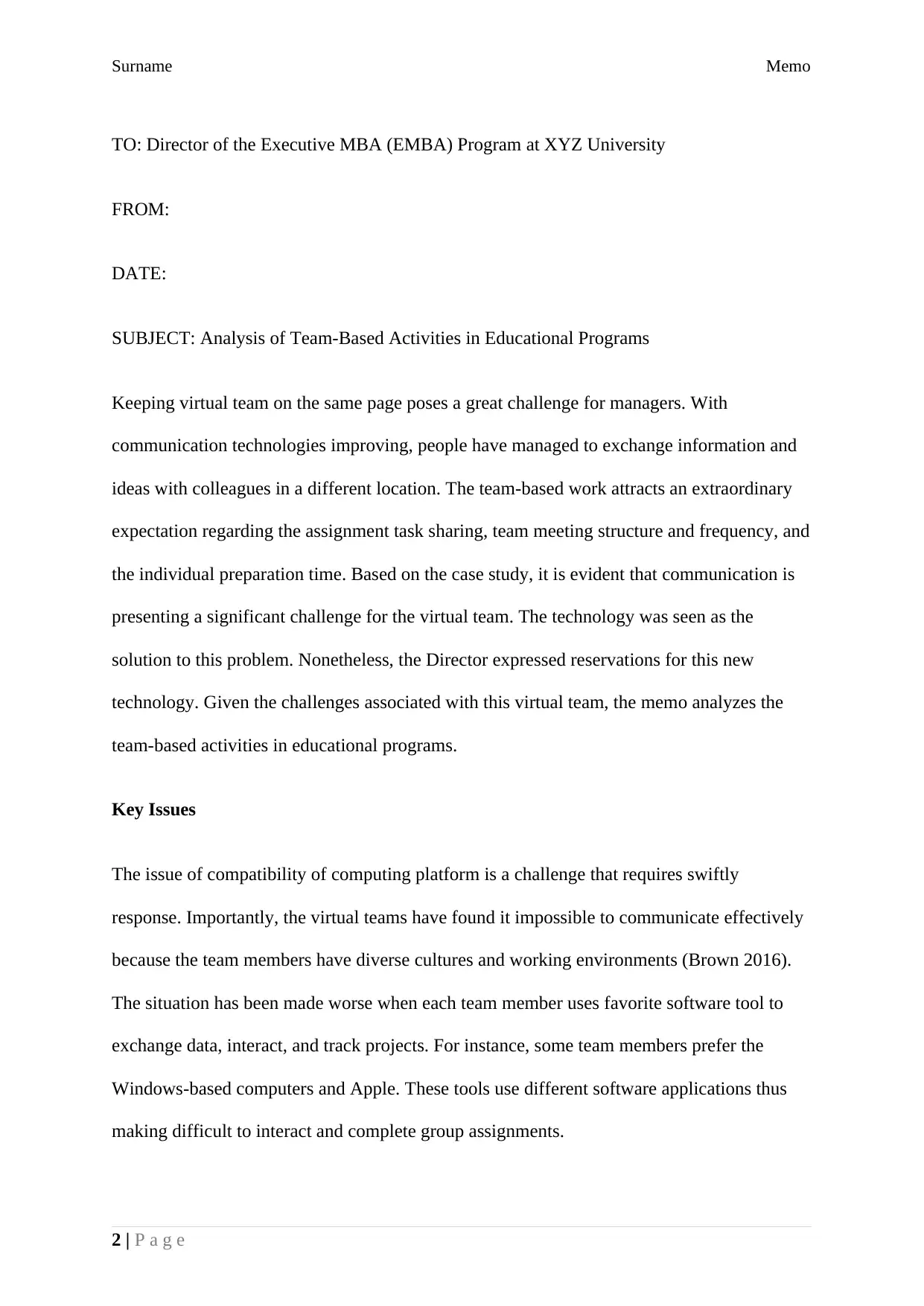
Surname Memo
TO: Director of the Executive MBA (EMBA) Program at XYZ University
FROM:
DATE:
SUBJECT: Analysis of Team-Based Activities in Educational Programs
Keeping virtual team on the same page poses a great challenge for managers. With
communication technologies improving, people have managed to exchange information and
ideas with colleagues in a different location. The team-based work attracts an extraordinary
expectation regarding the assignment task sharing, team meeting structure and frequency, and
the individual preparation time. Based on the case study, it is evident that communication is
presenting a significant challenge for the virtual team. The technology was seen as the
solution to this problem. Nonetheless, the Director expressed reservations for this new
technology. Given the challenges associated with this virtual team, the memo analyzes the
team-based activities in educational programs.
Key Issues
The issue of compatibility of computing platform is a challenge that requires swiftly
response. Importantly, the virtual teams have found it impossible to communicate effectively
because the team members have diverse cultures and working environments (Brown 2016).
The situation has been made worse when each team member uses favorite software tool to
exchange data, interact, and track projects. For instance, some team members prefer the
Windows-based computers and Apple. These tools use different software applications thus
making difficult to interact and complete group assignments.
2 | P a g e
TO: Director of the Executive MBA (EMBA) Program at XYZ University
FROM:
DATE:
SUBJECT: Analysis of Team-Based Activities in Educational Programs
Keeping virtual team on the same page poses a great challenge for managers. With
communication technologies improving, people have managed to exchange information and
ideas with colleagues in a different location. The team-based work attracts an extraordinary
expectation regarding the assignment task sharing, team meeting structure and frequency, and
the individual preparation time. Based on the case study, it is evident that communication is
presenting a significant challenge for the virtual team. The technology was seen as the
solution to this problem. Nonetheless, the Director expressed reservations for this new
technology. Given the challenges associated with this virtual team, the memo analyzes the
team-based activities in educational programs.
Key Issues
The issue of compatibility of computing platform is a challenge that requires swiftly
response. Importantly, the virtual teams have found it impossible to communicate effectively
because the team members have diverse cultures and working environments (Brown 2016).
The situation has been made worse when each team member uses favorite software tool to
exchange data, interact, and track projects. For instance, some team members prefer the
Windows-based computers and Apple. These tools use different software applications thus
making difficult to interact and complete group assignments.
2 | P a g e
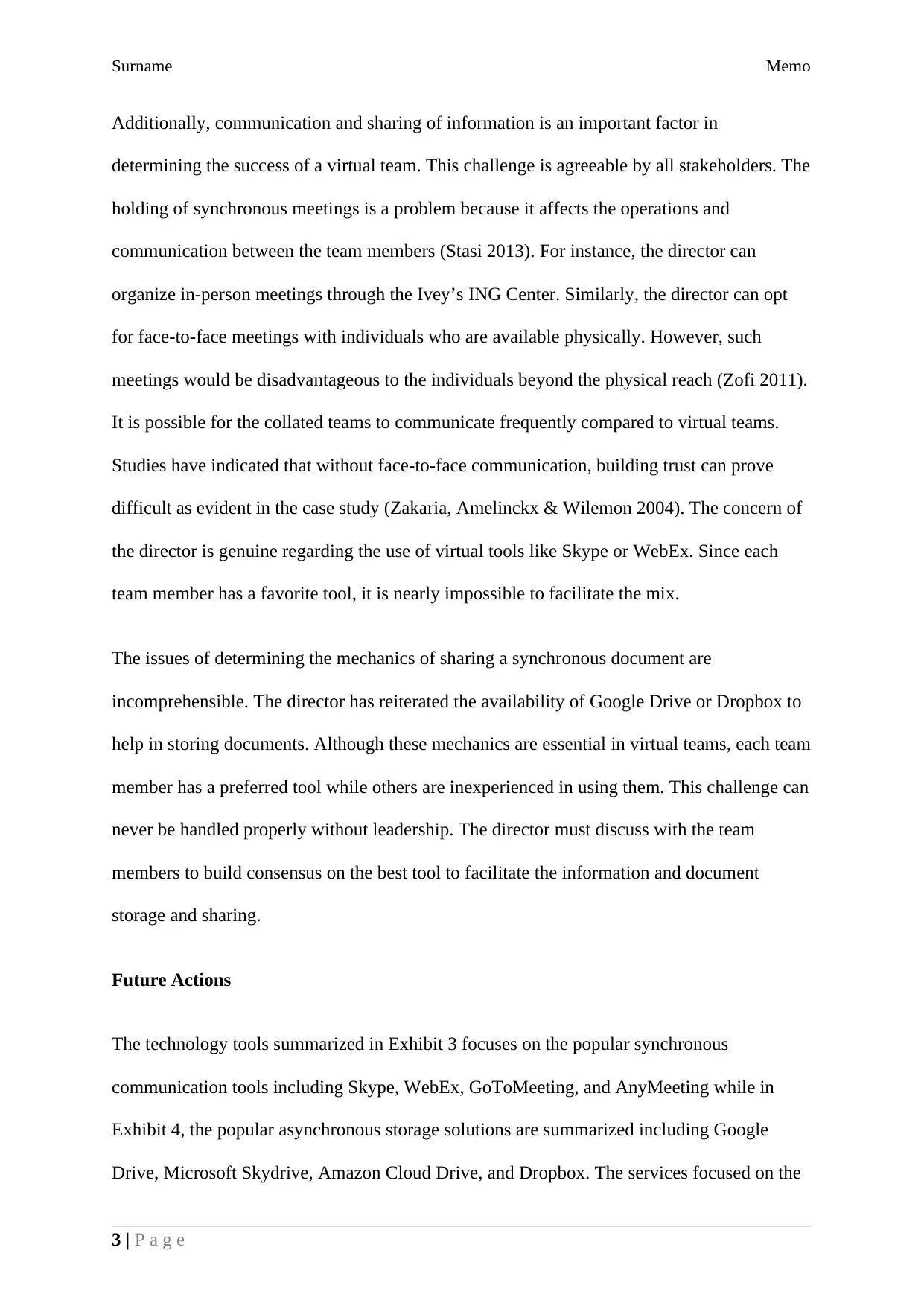
Surname Memo
Additionally, communication and sharing of information is an important factor in
determining the success of a virtual team. This challenge is agreeable by all stakeholders. The
holding of synchronous meetings is a problem because it affects the operations and
communication between the team members (Stasi 2013). For instance, the director can
organize in-person meetings through the Ivey’s ING Center. Similarly, the director can opt
for face-to-face meetings with individuals who are available physically. However, such
meetings would be disadvantageous to the individuals beyond the physical reach (Zofi 2011).
It is possible for the collated teams to communicate frequently compared to virtual teams.
Studies have indicated that without face-to-face communication, building trust can prove
difficult as evident in the case study (Zakaria, Amelinckx & Wilemon 2004). The concern of
the director is genuine regarding the use of virtual tools like Skype or WebEx. Since each
team member has a favorite tool, it is nearly impossible to facilitate the mix.
The issues of determining the mechanics of sharing a synchronous document are
incomprehensible. The director has reiterated the availability of Google Drive or Dropbox to
help in storing documents. Although these mechanics are essential in virtual teams, each team
member has a preferred tool while others are inexperienced in using them. This challenge can
never be handled properly without leadership. The director must discuss with the team
members to build consensus on the best tool to facilitate the information and document
storage and sharing.
Future Actions
The technology tools summarized in Exhibit 3 focuses on the popular synchronous
communication tools including Skype, WebEx, GoToMeeting, and AnyMeeting while in
Exhibit 4, the popular asynchronous storage solutions are summarized including Google
Drive, Microsoft Skydrive, Amazon Cloud Drive, and Dropbox. The services focused on the
3 | P a g e
Additionally, communication and sharing of information is an important factor in
determining the success of a virtual team. This challenge is agreeable by all stakeholders. The
holding of synchronous meetings is a problem because it affects the operations and
communication between the team members (Stasi 2013). For instance, the director can
organize in-person meetings through the Ivey’s ING Center. Similarly, the director can opt
for face-to-face meetings with individuals who are available physically. However, such
meetings would be disadvantageous to the individuals beyond the physical reach (Zofi 2011).
It is possible for the collated teams to communicate frequently compared to virtual teams.
Studies have indicated that without face-to-face communication, building trust can prove
difficult as evident in the case study (Zakaria, Amelinckx & Wilemon 2004). The concern of
the director is genuine regarding the use of virtual tools like Skype or WebEx. Since each
team member has a favorite tool, it is nearly impossible to facilitate the mix.
The issues of determining the mechanics of sharing a synchronous document are
incomprehensible. The director has reiterated the availability of Google Drive or Dropbox to
help in storing documents. Although these mechanics are essential in virtual teams, each team
member has a preferred tool while others are inexperienced in using them. This challenge can
never be handled properly without leadership. The director must discuss with the team
members to build consensus on the best tool to facilitate the information and document
storage and sharing.
Future Actions
The technology tools summarized in Exhibit 3 focuses on the popular synchronous
communication tools including Skype, WebEx, GoToMeeting, and AnyMeeting while in
Exhibit 4, the popular asynchronous storage solutions are summarized including Google
Drive, Microsoft Skydrive, Amazon Cloud Drive, and Dropbox. The services focused on the
3 | P a g e
⊘ This is a preview!⊘
Do you want full access?
Subscribe today to unlock all pages.

Trusted by 1+ million students worldwide
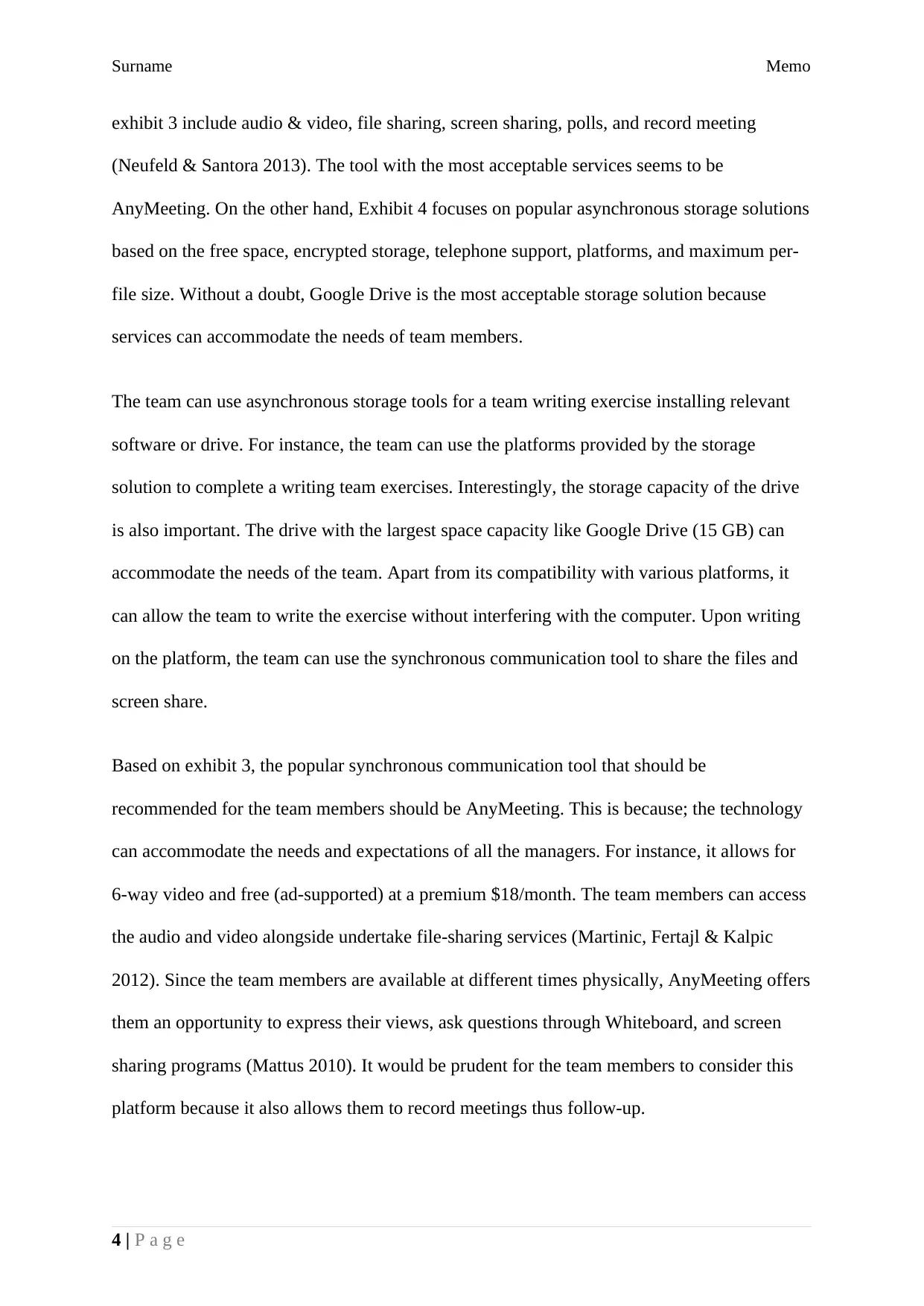
Surname Memo
exhibit 3 include audio & video, file sharing, screen sharing, polls, and record meeting
(Neufeld & Santora 2013). The tool with the most acceptable services seems to be
AnyMeeting. On the other hand, Exhibit 4 focuses on popular asynchronous storage solutions
based on the free space, encrypted storage, telephone support, platforms, and maximum per-
file size. Without a doubt, Google Drive is the most acceptable storage solution because
services can accommodate the needs of team members.
The team can use asynchronous storage tools for a team writing exercise installing relevant
software or drive. For instance, the team can use the platforms provided by the storage
solution to complete a writing team exercises. Interestingly, the storage capacity of the drive
is also important. The drive with the largest space capacity like Google Drive (15 GB) can
accommodate the needs of the team. Apart from its compatibility with various platforms, it
can allow the team to write the exercise without interfering with the computer. Upon writing
on the platform, the team can use the synchronous communication tool to share the files and
screen share.
Based on exhibit 3, the popular synchronous communication tool that should be
recommended for the team members should be AnyMeeting. This is because; the technology
can accommodate the needs and expectations of all the managers. For instance, it allows for
6-way video and free (ad-supported) at a premium $18/month. The team members can access
the audio and video alongside undertake file-sharing services (Martinic, Fertajl & Kalpic
2012). Since the team members are available at different times physically, AnyMeeting offers
them an opportunity to express their views, ask questions through Whiteboard, and screen
sharing programs (Mattus 2010). It would be prudent for the team members to consider this
platform because it also allows them to record meetings thus follow-up.
4 | P a g e
exhibit 3 include audio & video, file sharing, screen sharing, polls, and record meeting
(Neufeld & Santora 2013). The tool with the most acceptable services seems to be
AnyMeeting. On the other hand, Exhibit 4 focuses on popular asynchronous storage solutions
based on the free space, encrypted storage, telephone support, platforms, and maximum per-
file size. Without a doubt, Google Drive is the most acceptable storage solution because
services can accommodate the needs of team members.
The team can use asynchronous storage tools for a team writing exercise installing relevant
software or drive. For instance, the team can use the platforms provided by the storage
solution to complete a writing team exercises. Interestingly, the storage capacity of the drive
is also important. The drive with the largest space capacity like Google Drive (15 GB) can
accommodate the needs of the team. Apart from its compatibility with various platforms, it
can allow the team to write the exercise without interfering with the computer. Upon writing
on the platform, the team can use the synchronous communication tool to share the files and
screen share.
Based on exhibit 3, the popular synchronous communication tool that should be
recommended for the team members should be AnyMeeting. This is because; the technology
can accommodate the needs and expectations of all the managers. For instance, it allows for
6-way video and free (ad-supported) at a premium $18/month. The team members can access
the audio and video alongside undertake file-sharing services (Martinic, Fertajl & Kalpic
2012). Since the team members are available at different times physically, AnyMeeting offers
them an opportunity to express their views, ask questions through Whiteboard, and screen
sharing programs (Mattus 2010). It would be prudent for the team members to consider this
platform because it also allows them to record meetings thus follow-up.
4 | P a g e
Paraphrase This Document
Need a fresh take? Get an instant paraphrase of this document with our AI Paraphraser
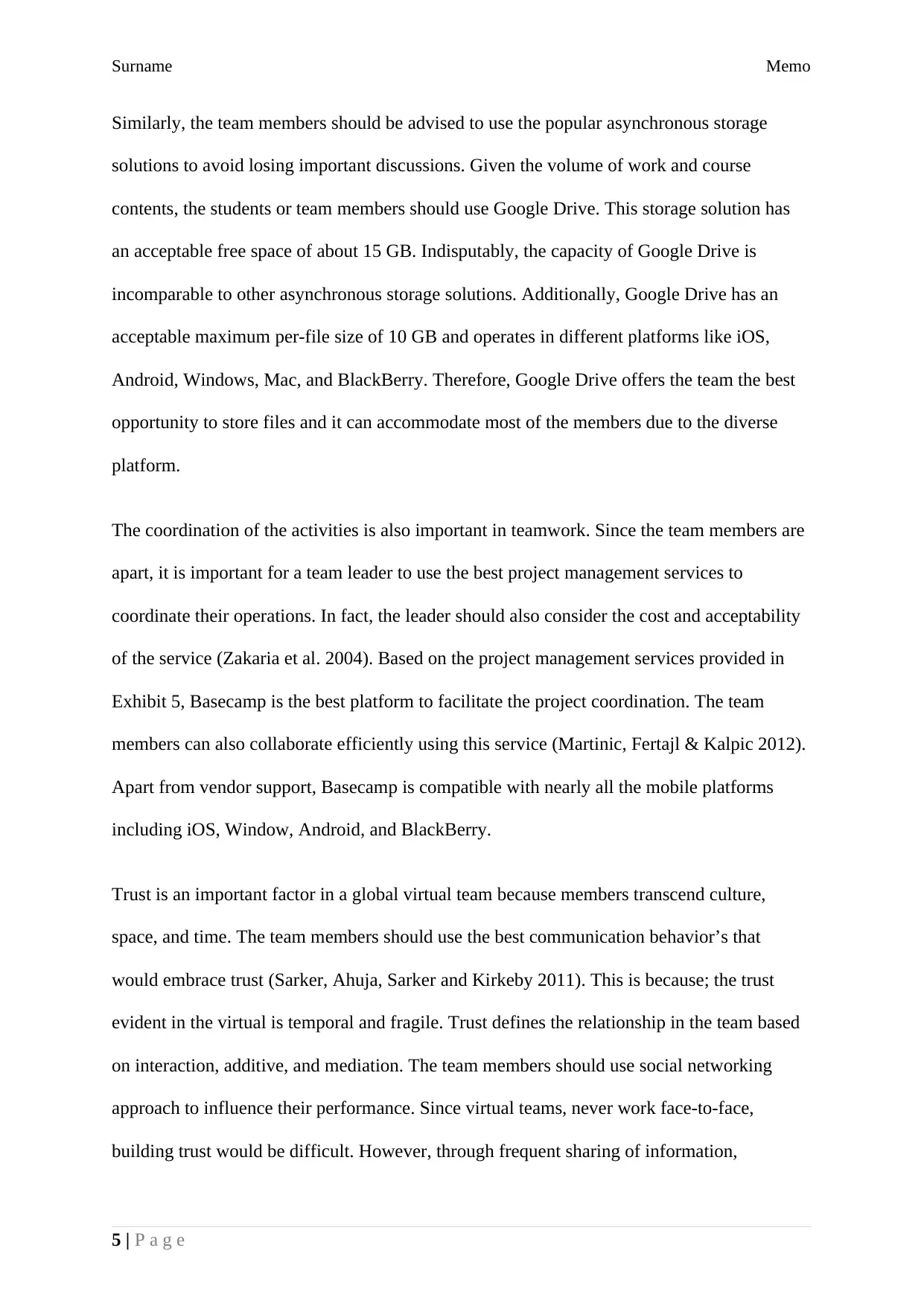
Surname Memo
Similarly, the team members should be advised to use the popular asynchronous storage
solutions to avoid losing important discussions. Given the volume of work and course
contents, the students or team members should use Google Drive. This storage solution has
an acceptable free space of about 15 GB. Indisputably, the capacity of Google Drive is
incomparable to other asynchronous storage solutions. Additionally, Google Drive has an
acceptable maximum per-file size of 10 GB and operates in different platforms like iOS,
Android, Windows, Mac, and BlackBerry. Therefore, Google Drive offers the team the best
opportunity to store files and it can accommodate most of the members due to the diverse
platform.
The coordination of the activities is also important in teamwork. Since the team members are
apart, it is important for a team leader to use the best project management services to
coordinate their operations. In fact, the leader should also consider the cost and acceptability
of the service (Zakaria et al. 2004). Based on the project management services provided in
Exhibit 5, Basecamp is the best platform to facilitate the project coordination. The team
members can also collaborate efficiently using this service (Martinic, Fertajl & Kalpic 2012).
Apart from vendor support, Basecamp is compatible with nearly all the mobile platforms
including iOS, Window, Android, and BlackBerry.
Trust is an important factor in a global virtual team because members transcend culture,
space, and time. The team members should use the best communication behavior’s that
would embrace trust (Sarker, Ahuja, Sarker and Kirkeby 2011). This is because; the trust
evident in the virtual is temporal and fragile. Trust defines the relationship in the team based
on interaction, additive, and mediation. The team members should use social networking
approach to influence their performance. Since virtual teams, never work face-to-face,
building trust would be difficult. However, through frequent sharing of information,
5 | P a g e
Similarly, the team members should be advised to use the popular asynchronous storage
solutions to avoid losing important discussions. Given the volume of work and course
contents, the students or team members should use Google Drive. This storage solution has
an acceptable free space of about 15 GB. Indisputably, the capacity of Google Drive is
incomparable to other asynchronous storage solutions. Additionally, Google Drive has an
acceptable maximum per-file size of 10 GB and operates in different platforms like iOS,
Android, Windows, Mac, and BlackBerry. Therefore, Google Drive offers the team the best
opportunity to store files and it can accommodate most of the members due to the diverse
platform.
The coordination of the activities is also important in teamwork. Since the team members are
apart, it is important for a team leader to use the best project management services to
coordinate their operations. In fact, the leader should also consider the cost and acceptability
of the service (Zakaria et al. 2004). Based on the project management services provided in
Exhibit 5, Basecamp is the best platform to facilitate the project coordination. The team
members can also collaborate efficiently using this service (Martinic, Fertajl & Kalpic 2012).
Apart from vendor support, Basecamp is compatible with nearly all the mobile platforms
including iOS, Window, Android, and BlackBerry.
Trust is an important factor in a global virtual team because members transcend culture,
space, and time. The team members should use the best communication behavior’s that
would embrace trust (Sarker, Ahuja, Sarker and Kirkeby 2011). This is because; the trust
evident in the virtual is temporal and fragile. Trust defines the relationship in the team based
on interaction, additive, and mediation. The team members should use social networking
approach to influence their performance. Since virtual teams, never work face-to-face,
building trust would be difficult. However, through frequent sharing of information,
5 | P a g e
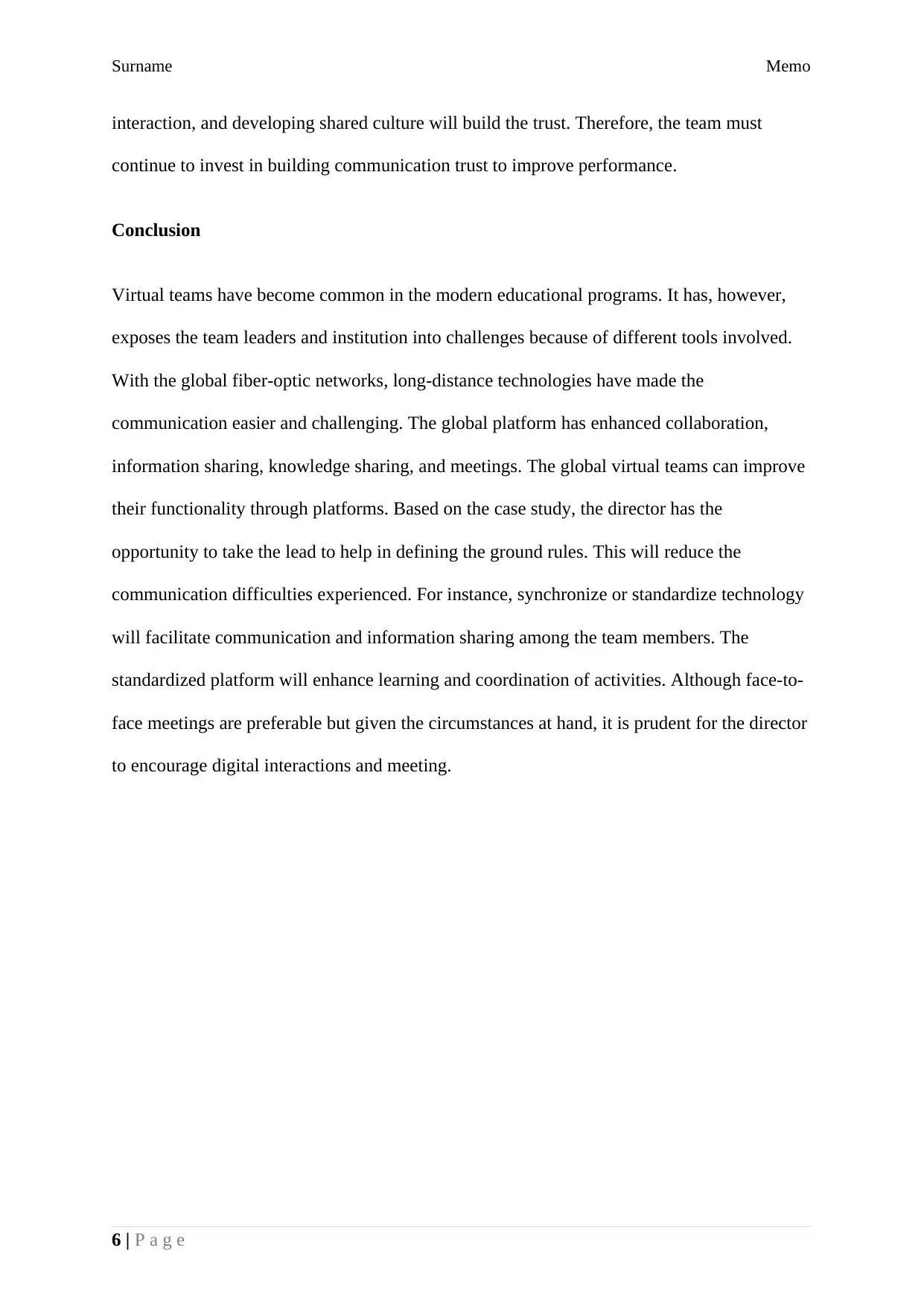
Surname Memo
interaction, and developing shared culture will build the trust. Therefore, the team must
continue to invest in building communication trust to improve performance.
Conclusion
Virtual teams have become common in the modern educational programs. It has, however,
exposes the team leaders and institution into challenges because of different tools involved.
With the global fiber-optic networks, long-distance technologies have made the
communication easier and challenging. The global platform has enhanced collaboration,
information sharing, knowledge sharing, and meetings. The global virtual teams can improve
their functionality through platforms. Based on the case study, the director has the
opportunity to take the lead to help in defining the ground rules. This will reduce the
communication difficulties experienced. For instance, synchronize or standardize technology
will facilitate communication and information sharing among the team members. The
standardized platform will enhance learning and coordination of activities. Although face-to-
face meetings are preferable but given the circumstances at hand, it is prudent for the director
to encourage digital interactions and meeting.
6 | P a g e
interaction, and developing shared culture will build the trust. Therefore, the team must
continue to invest in building communication trust to improve performance.
Conclusion
Virtual teams have become common in the modern educational programs. It has, however,
exposes the team leaders and institution into challenges because of different tools involved.
With the global fiber-optic networks, long-distance technologies have made the
communication easier and challenging. The global platform has enhanced collaboration,
information sharing, knowledge sharing, and meetings. The global virtual teams can improve
their functionality through platforms. Based on the case study, the director has the
opportunity to take the lead to help in defining the ground rules. This will reduce the
communication difficulties experienced. For instance, synchronize or standardize technology
will facilitate communication and information sharing among the team members. The
standardized platform will enhance learning and coordination of activities. Although face-to-
face meetings are preferable but given the circumstances at hand, it is prudent for the director
to encourage digital interactions and meeting.
6 | P a g e
⊘ This is a preview!⊘
Do you want full access?
Subscribe today to unlock all pages.

Trusted by 1+ million students worldwide
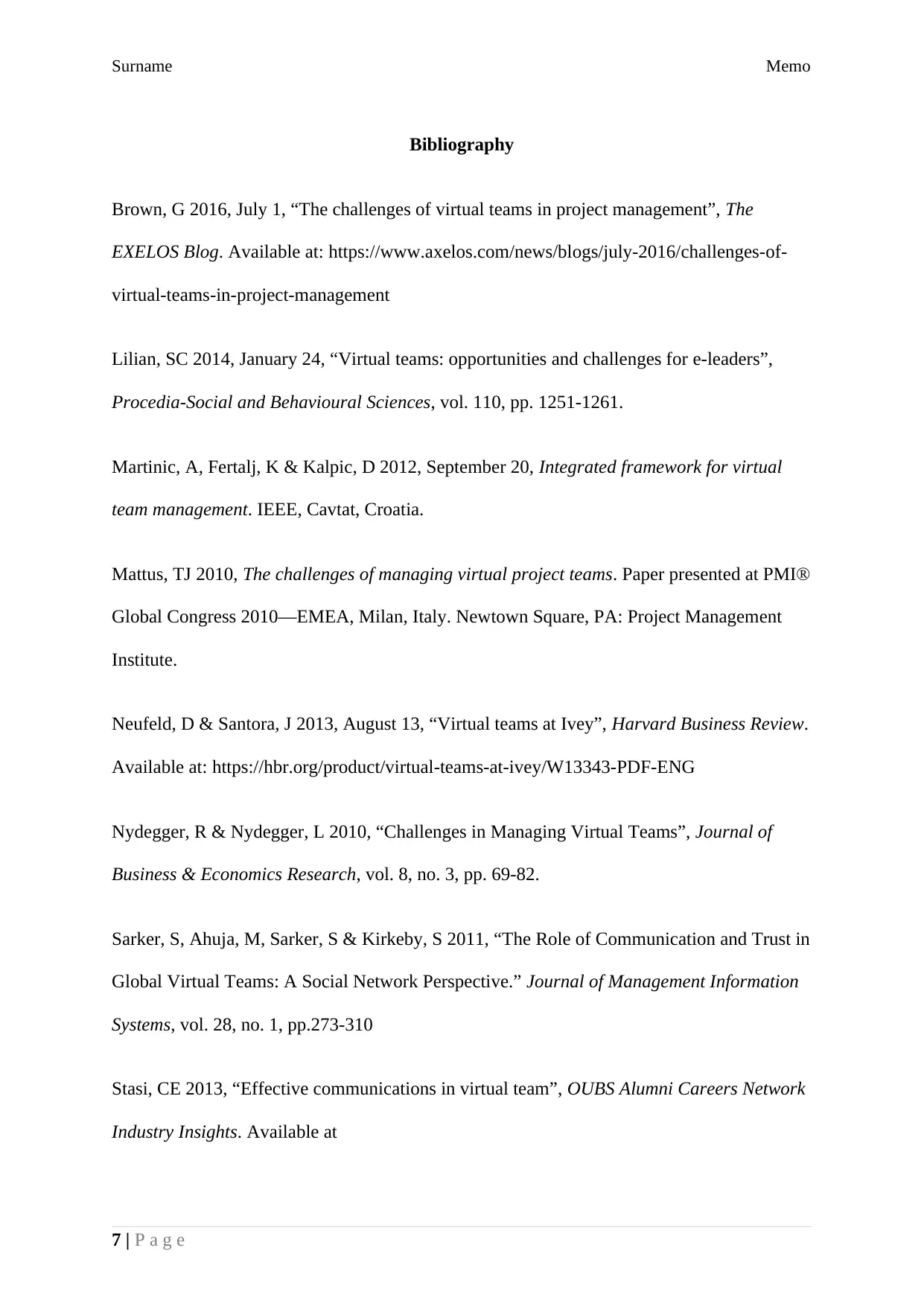
Surname Memo
Bibliography
Brown, G 2016, July 1, “The challenges of virtual teams in project management”, The
EXELOS Blog. Available at: https://www.axelos.com/news/blogs/july-2016/challenges-of-
virtual-teams-in-project-management
Lilian, SC 2014, January 24, “Virtual teams: opportunities and challenges for e-leaders”,
Procedia-Social and Behavioural Sciences, vol. 110, pp. 1251-1261.
Martinic, A, Fertalj, K & Kalpic, D 2012, September 20, Integrated framework for virtual
team management. IEEE, Cavtat, Croatia.
Mattus, TJ 2010, The challenges of managing virtual project teams. Paper presented at PMI®
Global Congress 2010—EMEA, Milan, Italy. Newtown Square, PA: Project Management
Institute.
Neufeld, D & Santora, J 2013, August 13, “Virtual teams at Ivey”, Harvard Business Review.
Available at: https://hbr.org/product/virtual-teams-at-ivey/W13343-PDF-ENG
Nydegger, R & Nydegger, L 2010, “Challenges in Managing Virtual Teams”, Journal of
Business & Economics Research, vol. 8, no. 3, pp. 69-82.
Sarker, S, Ahuja, M, Sarker, S & Kirkeby, S 2011, “The Role of Communication and Trust in
Global Virtual Teams: A Social Network Perspective.” Journal of Management Information
Systems, vol. 28, no. 1, pp.273-310
Stasi, CE 2013, “Effective communications in virtual team”, OUBS Alumni Careers Network
Industry Insights. Available at
7 | P a g e
Bibliography
Brown, G 2016, July 1, “The challenges of virtual teams in project management”, The
EXELOS Blog. Available at: https://www.axelos.com/news/blogs/july-2016/challenges-of-
virtual-teams-in-project-management
Lilian, SC 2014, January 24, “Virtual teams: opportunities and challenges for e-leaders”,
Procedia-Social and Behavioural Sciences, vol. 110, pp. 1251-1261.
Martinic, A, Fertalj, K & Kalpic, D 2012, September 20, Integrated framework for virtual
team management. IEEE, Cavtat, Croatia.
Mattus, TJ 2010, The challenges of managing virtual project teams. Paper presented at PMI®
Global Congress 2010—EMEA, Milan, Italy. Newtown Square, PA: Project Management
Institute.
Neufeld, D & Santora, J 2013, August 13, “Virtual teams at Ivey”, Harvard Business Review.
Available at: https://hbr.org/product/virtual-teams-at-ivey/W13343-PDF-ENG
Nydegger, R & Nydegger, L 2010, “Challenges in Managing Virtual Teams”, Journal of
Business & Economics Research, vol. 8, no. 3, pp. 69-82.
Sarker, S, Ahuja, M, Sarker, S & Kirkeby, S 2011, “The Role of Communication and Trust in
Global Virtual Teams: A Social Network Perspective.” Journal of Management Information
Systems, vol. 28, no. 1, pp.273-310
Stasi, CE 2013, “Effective communications in virtual team”, OUBS Alumni Careers Network
Industry Insights. Available at
7 | P a g e
Paraphrase This Document
Need a fresh take? Get an instant paraphrase of this document with our AI Paraphraser
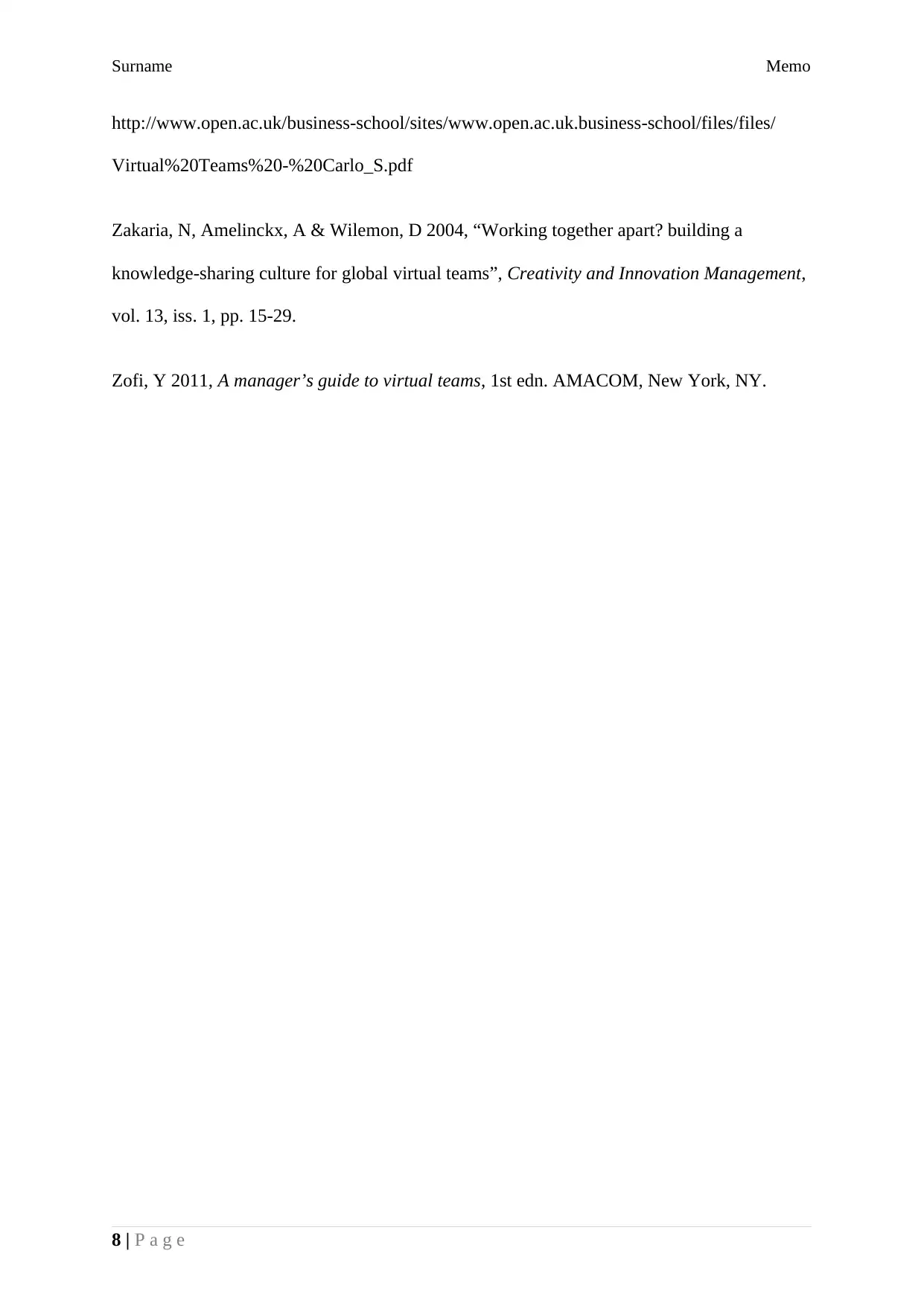
Surname Memo
http://www.open.ac.uk/business-school/sites/www.open.ac.uk.business-school/files/files/
Virtual%20Teams%20-%20Carlo_S.pdf
Zakaria, N, Amelinckx, A & Wilemon, D 2004, “Working together apart? building a
knowledge-sharing culture for global virtual teams”, Creativity and Innovation Management,
vol. 13, iss. 1, pp. 15-29.
Zofi, Y 2011, A manager’s guide to virtual teams, 1st edn. AMACOM, New York, NY.
8 | P a g e
http://www.open.ac.uk/business-school/sites/www.open.ac.uk.business-school/files/files/
Virtual%20Teams%20-%20Carlo_S.pdf
Zakaria, N, Amelinckx, A & Wilemon, D 2004, “Working together apart? building a
knowledge-sharing culture for global virtual teams”, Creativity and Innovation Management,
vol. 13, iss. 1, pp. 15-29.
Zofi, Y 2011, A manager’s guide to virtual teams, 1st edn. AMACOM, New York, NY.
8 | P a g e
1 out of 8
Related Documents
Your All-in-One AI-Powered Toolkit for Academic Success.
+13062052269
info@desklib.com
Available 24*7 on WhatsApp / Email
![[object Object]](/_next/static/media/star-bottom.7253800d.svg)
Unlock your academic potential
Copyright © 2020–2025 A2Z Services. All Rights Reserved. Developed and managed by ZUCOL.




